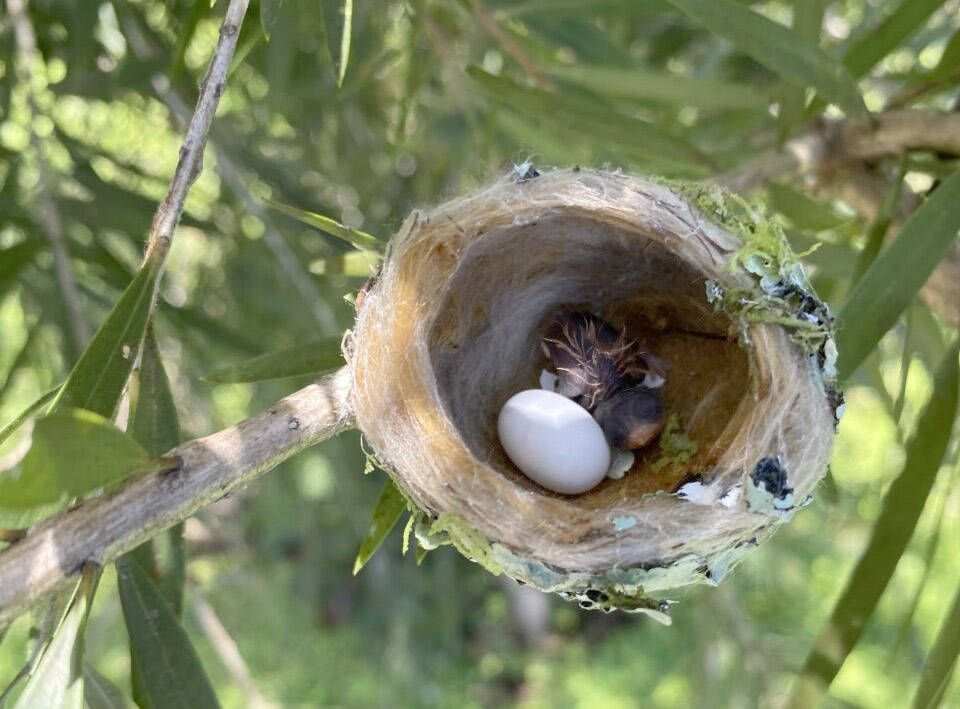Bird nerd, bird geek and bird brain are just a few of the accolades I have acquired over the years. Of course, these labels were probably well deserved as the accumulation of seemingly useless information about the life histories of a particular bird species appears to have little value in our daily lives.
These tidbits provide good conversation among other factoid gatherers, but what else? Quite a bit, actually.
In a recent conversation with researchers in British Columbia, Canada, we discussed the phenomenon of Anna’s hummingbirds maintaining simultaneous nests.
We often expound on the Herculean task of bird mothers for building a nest, laying eggs, keeping the eggs warm, and then running her body into the ground to feed those nestlings before the young birds launch off on their own.
We are now seeing mothers taking it a step further and determining that the nestlings can maintain their body temperature. So why not build another nest and lay some more eggs?
Then throw in the fact that while building the second nest, laying eggs and incubating them, she is still spending every last minute collecting food for the hungry, growing mouths in the first nest. This seemingly impossible task allows her to pull off multiple nesting attempts and create more opportunities to increase the population in the same nesting period.
Overlapping nesting is not restricted to one species or even one group of species.
For example, banded Costa’s hummingbirds were recently documented by Dave Boyarski’s team in southern Nevada to have accomplished simultaneous nests by the same female in two and sometimes three times in the same nesting season. Thus, one bird that only produces two eggs per nest fledged five new birds in one short nesting period.
Is this another of those “useless” facts that we have learned about birds?
We are already starting to see a lot of tweaks and changes to our bird populations and assemblages related to a changing climate and resulting habitat. Indications are that these changes, through range expansion or contraction and changes in population density, will only continue and grow.
We are seeing a lot of species that are losing viable habitat on the southern end of their breeding range and expanding on the northern end of their range.
This trivial fact that some birds nest multiple times and maintain overlapping nests in the same season may seem like a minor deal. Imagine if we lose 500 miles of range on the southern end and gain 400 miles of new habitat in the northern latitudes. This seems like a relatively minor loss.
Unfortunately, as we learn more, the end result may be losing two to three or more nesting attempts per season on the southern end and replacing it with one nesting attempt up north where the breeding season is much shorter. This loss is exponential, and without this information we would be left with our conventional wisdom and would say it reflects the range simply adjusting to change and moving north.
For me, this “ah ha” moment of connecting all the dots matches the visualization of the impacts of tree line rise. The first time I saw a graphic of a cone (i.e., mountain) and saw how every foot of tree line rise represented exponential loss of the actual area of available habitat for our alpine species like Dall’s sheep, our three species of ptarmigan and hoary marmots, I was stunned.
Not every change we see can or should be attributed solely to a changing climate. In the case of bird species that are shifting their ranges north, it may not matter what the root driver is for the shifting range, i.e., climate change.
Instead, the trading of three more nesting attempts per season for one is a fact that results in less of that species. This fact alone leads me to believe that I owe the new arrivals every opportunity to succeed as stewards of the new breeding grounds.
For me, this means being cognizant of the other threats that migrant birds face after flying all the way up to Alaska to raise young. Not to mention the fact that some are only coming here now in response to the original threat of a changing climate. On my own plot of land this means keeping my cats indoors and providing habitat that supports birds.
This summer, I will be helping create a hummingbird-friendly native garden both at my home and at the Alaska Wildlife Conservation Center. While the focus is providing plants supportive of hummingbirds, many of our native pollinators will also benefit.
My hope is that, showcasing native pollinator gardens will also spark visitors to come up with their own ideas on how they can design wildlife friendly places on their own property. We often hear about death by a thousand cuts, but I would love to see that turned into life by a thousand tiny slices of pie!
Todd Eskelin is a Wildlife Biologist at Kenai National Wildlife Refuge. Find more Refuge Notebook articles (1999-present) at https://www.fws.gov/Refuge/Kenai/community/Refuge_notebook.html or other info at http://www.facebook.com/kenainationalwildliferefuge.

